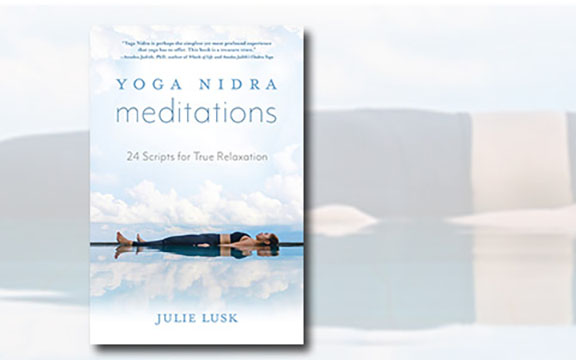 Julie Lusk, MEd, E-RYT-500, NCC, has a new book out: Yoga Nidra Meditations: 24 Scripts for True Relaxation. Featuring twenty-four Yoga Nidra scripts written by author Julie Lusk and thirteen of the world’s master teachers—including Swami Satchidananda—this book shows you how to use yogic sleep to revitalize your inner reservoir of intuitive understanding and unconditional joy. In this article, She explains what Yoga Nidra is and how it works on the body and mind, as well as the Yoga koshas.
Julie Lusk, MEd, E-RYT-500, NCC, has a new book out: Yoga Nidra Meditations: 24 Scripts for True Relaxation. Featuring twenty-four Yoga Nidra scripts written by author Julie Lusk and thirteen of the world’s master teachers—including Swami Satchidananda—this book shows you how to use yogic sleep to revitalize your inner reservoir of intuitive understanding and unconditional joy. In this article, She explains what Yoga Nidra is and how it works on the body and mind, as well as the Yoga koshas.
Yoga Nidra is “yogic sleep.” It’s a profoundly healing and empowering meditation that starts with six levels of relaxation and deeply restorative rest done lying down for a joyful meditative experience. Yoga Nidra shines because it blends Yoga’s ancient and modern wisdom teachings with proven state-of-the-art tools and techniques that are unifying and uplifting to the body, mind, and spirit. Yoga Nidra is a state of important conscious awareness.
Relaxation is the road taken, not the destination. The ultimate purpose of Yoga Nidra is to realize that each of us has an inborn reservoir of positive energy just waiting to be discovered and used. Yoga sages refer to it as the Atman, or our true nature. It is unconditionally peaceful and joyful and is spacious and free. These treasures are always present. This essence-nature is everlasting and cannot be harmed in any way. According to Yoga sages, this aspect of oneself is typically hidden under koshas, the Sanskrit term for layers. The five of them are described below. We are under the illusion that these layers are the entirety of who we are because we are so familiar with them.
Recognizing these important layers for what they are and learning to put them to rest for a while is healing and rejuvenating. Specialized relaxation exercises, breathing techniques, meditation, and guided imagery are used for this in a systematic, progressive way. This process typically takes about 30 minutes. Yoga Nidra is not just for Yoga enthusiasts. Novices to experts and kids to elders can successfully practice Yoga Nidra using the meditation scripts in my book, Yoga Nidra Meditations: 24 Scripts for True Relaxation. The book begins with Swami Satchidananda’s Guided Relaxation script.
Backed by contemporary science, specialized meditations are included from other leading experts for easing anxiety, lifting the blues, boosting immunity, helping to reduce chronic pain, improving heart health, enhancing memory, increasing concentration, and much more. You’ll enjoy experiencing your own calm spot, energy enrichment, and an expansion of your consciousness. It’s blissful meditation without having to try.
 Yoga Nidra is usually done in a Yoga posture called savasana, which is simply lying down. Sitting in a comfortable chair is another option. Here are the six levels of conscious relaxation experienced by balancing, healing, and relaxing the koshas (layers) as described in the book.
Yoga Nidra is usually done in a Yoga posture called savasana, which is simply lying down. Sitting in a comfortable chair is another option. Here are the six levels of conscious relaxation experienced by balancing, healing, and relaxing the koshas (layers) as described in the book.
6 Levels of Yoga Nidra
- Deep calm, feeling grounded, and healing. Anna-maya kosha refers to the physical body. Dropping bodily tension reduces muscular tension and increases flow. The nervous system becomes balanced by stimulating the relaxation response by activating the parasympathetic nervous system. Health improvement takes place as physical tension releases. A delightful feeling of deep calm and heaviness happen. A variety of relaxation techniques can be used. Examples include progressive muscle relaxation by tensing and releasing every muscle group sequentially. Another method is to take a mental tour throughout the body based upon the brain’s sensory motor cortex, the chakras, and nerve centers called marma Autogenic relaxation is another approach that utilizes autosuggestion.
- Energy enrichment. Prana-maya kosha refers to the energetic body. Relaxing energetically soothes the static while balancing the body and mind. A sense of inner stillness accompanies deep relaxation. This is primarily done by using specialized breathing techniques. The enjoyment of being motionless naturally occurs as breathing deepens. Balancing the chakras is another way. Depending on the techniques used, this can feel either calming or energizing. During this stage, thoughts start moving effortlessly into the background.
- Mental clarity and emotional well-being. Mano-maya kosha refers to thoughts, feelings, and beliefs. Mental restlessness, emotional turmoil, and limiting beliefs can be released and calmed during this stage. Feeling light and buoyant are experienced during this phase due to the relief of not being “held down” by physical, mental, and emotional tension. It feels like floating without a care in the world. Imagination and creativity awaken and it’s dreamlike. Subtle tensions and stress are released. Guided visualization, mindfulness, mantra repetition, and a technique called the paradox of opposites are some of the techniques that can be used.
- Inner insights and awareness are unleashed. Vijnana-maya kosha refers to the realm of intuition, higher intellect, and wisdom. When the mind is no longer burdened by limiting thoughts, feelings, and beliefs, one’s soulful wisdom is set free. A sense of detachment from worldly cares, weightlessness, and lightness are experienced as the intellect and ego go offline for a while. It is non-mental and goes beyond rational thinking. Witness awareness, guided imagination, and simply being quiet are key techniques here. done lying down or in a comfortable chair.
- Bliss. Ananda-maya kosha is pure, unconditional peace and joy. Total and complete relaxation naturally happen when all the other layers are resting and relaxing, healing and restoring. It is soul-quenching and supremely tranquil. The sense of time disappears as expansiveness flourishes.
- Pure awareness. Profound contentment, a sense of oneness, and awareness of existence beyond the body-mind arise as all one’s layers are transcended, and one’s essence-nature is experienced firsthand. As this happens, self-understanding and sensing divinity is realized. The Atman is not a separate “being” and is not a kosha. It is our essence-nature, which is pure Awareness.
Yoga Nidra gives us a new, uplifting perspective that is centered and grounded. Feeling mental clarity, alertness, and relaxed energy are common. The way to find out for yourself is to experience it personally.
SPECIAL NOTE: Yoga Nidra Training and Certification Level 1 with Julie Lusk, E-RYT 500, M.Ed. September 3 – 8, 2021 and Level 2: September 10 – 15, 2021 in Yogaville.
 About the Author:
About the Author:
Julie Lusk, MEd, E-RYT-500, NCC, has specialized in Yoga, relaxation training, guided imagery, and meditation for decades. An international writer, recording artist, and workshop leader, Julie is talented in bringing the best out in others through her depth of knowledge, natural lightheartedness, and caring nature. Julie has written six books, including her latest Yoga Nidra Meditations: 24 Scripts for True Relaxation (Llewellyn Publications, 2021).

